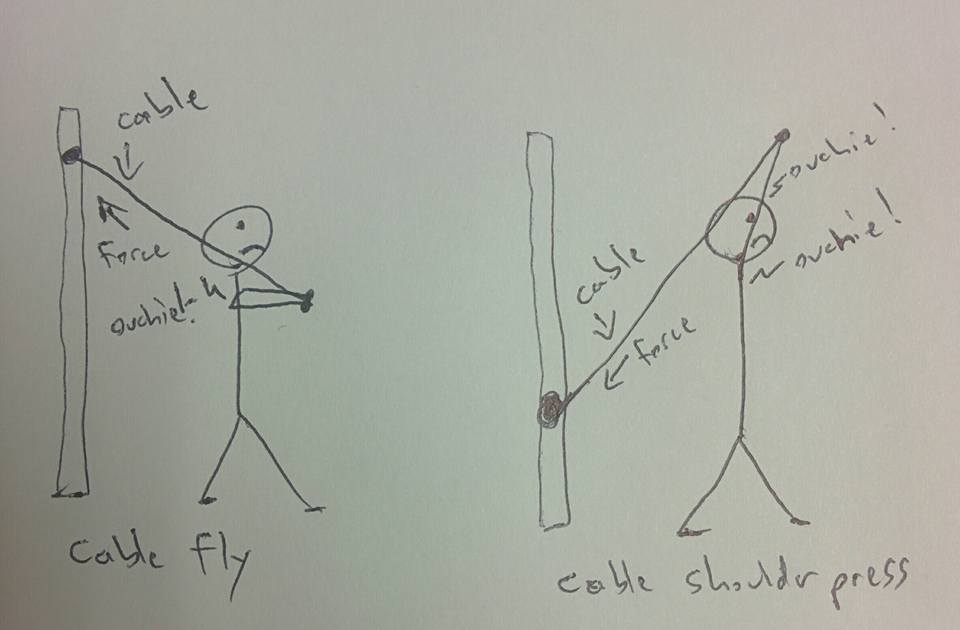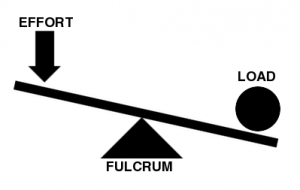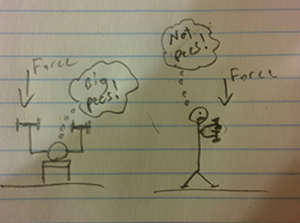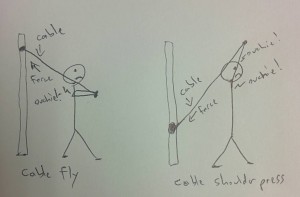Even seemingly rational and educated people seem to throw common sense out the window when they step into the weight room. So, I started a fun little series of crappy drawings called “Stickman Biomechanics” on Facebook explaining basic biomechanics and to give people some pause before they “just do it, Brah.”
Today I bring you 2 super common exercises that I see in most gyms on a regular basis. Both of these are perfect examples of mimicking motion without regard to what is actually happening.
Some basics of resistance training that need to be understood:
- Look at the diagram below. Our limbs are levers. Think of your joints as the “fulcrums.” Look at “effort” as the contraction of the muscle to move the lever (pushing, pulling, etc). The “load” is the weight. The crazy thing about the human body though is that there are multiple “fulcrums” down the length of the lever. Experiment: stick your arm out straight and hold a weight in your hand. Identify the “fulcrums”: wrist, elbow, shoulder (for simplicity sake we are leaving out everything else further along the chain-spine, hips, etc.). Notice how your shoulder is getting significantly more tired than your wrist. That is because the “effort” of the shoulder muscles is closest to the “fulcrum” of the glenohumeral joint, which is furthest away from the “load”, creating the most force.
It’s science, bitches!
OK. Now look at an anatomy chart and notice which muscles are responsible for moving the “lever” at each “fulcrum”.
Please, baby Jesus, tell me this makes sense.
OK. Now, you should also notice that each “fulcrum” or joint has a preferred motion. For example: your elbow likes to flex and extend your arm. It does not like to move perpendicular to that movement. That’s called a lateral condyle fracture, and that will ruin your day. So, it goes without saying, that you should not load a joint in a way that forces it outside of its range of motion.
OK, now for the muscle stuff. In order to work a particular muscle, you need to apply force in such a way that the muscle MUST respond to control the joint you are applying force to. Look at the pectorals. You do a dumbbell chest press on your back because this allows the force to be applied to the joint in such a way that the pectorals (ignoring secondary muscles) is responsible for controlling that movement (because gravity wants to bring the weight to the floor). You can mimic the same motion standing, but the force is now applied primarily to the deltoids, rather than the pecs (once again…gravity).
The cool thing about gravity is that it is always applying force downward.
The cool thing about free cables is that they are always applying force in the direction of the cable.
This means that it is crucial that you adjust the cable to correspond with how you want to apply force to the joint (and surrounding muscle). A lot of people ignore the force and just make the movement.
Note the examples below.
In a cable fly, if you have the cable adjusted at an upward angle, but you are moving your arms parallel to the floor with the intent of working your pecs, you are applying force at the wrong angle (this is why you see people leaning forward in a fly to change the angle of the joint in correspondence with the force-although most people don’t realize why they are doing it).
In a cable shoulder press, the same rules apply. Pay attention to the force angle and what muscles are actually being used to control that force. To do this correctly (assuming you want to work the deltoids), the line of force would need to be almost directly straight down.
Stickman is sad because:
a) the force is creating torque in an unnatural way against the joint and that shit hurts
b) stickman can’t feel the muscle working the way he would like
c) he will never get jacked and swolt
BONUS: Cable flyes can be AWESOME for pec development if used correctly. It’s super easy to change the direction of force by just stepping forward or backing up more. Remember, the cable is the direction of force, so it makes it easy to see.
Remember, friends, your body is a machine and physics applies to its movement just like any other machine.
Also published on Medium.








